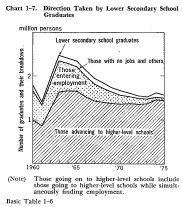| Home > Policy > White Paper, Notice, Announcement > White Paper > EDUCATIONAL STANDARDS IN JAPAN 1975 > CHAPTER1 2 (3) | ||
Out of about 1,580,000 lower secondary school graduates in March, 1975, 1,450,000 went on to the schools of a higher level (this figure includes those who went on to higher-level schools while entering employment; the same shall apply hereafter), 60,000 found employment (this figure excludes those who went on to higher-level schools while entering employment; the same shall apply hereafter) and 60,000 were those of other categories (who did not take either of the two directions as mentioned above, or died, or whose post-graduation direction could not be traced).
As for transition in the type of directions chosen by lower secondary school graduates, Chart 1-7 shows that the peak in the number of graduates was reached in 1963 (at 2,490,000 persons), that of those who went on to higher-level schools, in 1964 (at 1,680,000 persons who accounted for 69.3% of all graduates), and that of those who found employment, in 1963 (at 690,000 persons). Thereafter, the number of graduates has been in gradual decline, but the number of the graduates who went on to higher-level schools has been turning upward, as corroborated by the increase in the rate of their advancement to higher-level schools (from 57.7% in 1960 to 9l.9% in 1975), while the number of graduates finding employment has been in consistent decline.

| Back to Top | MEXT HOME |